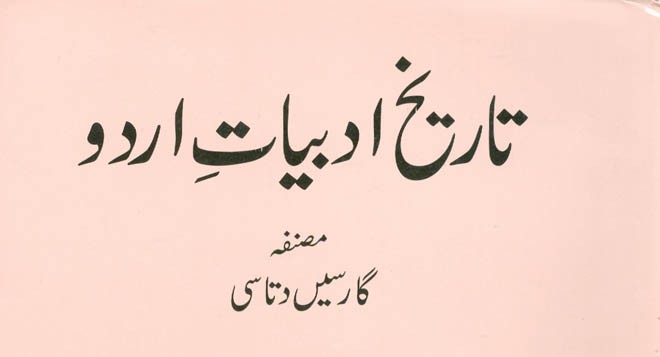
A pathbreaking work on Urdu literature by a French scholar

In the nineteenth century, many in Europe were deeply interested in the study of the East. Known as orientalists, they were genuine scholars who despite the differences in culture and background made all possible effort to understand at that time the very different east.
There are many cynics who would say that all these scholars were furthering the imperial interests of the European powers, but even if they did, their understanding probed the well springs and fountainheads of knowledge of the east, adding another dimension to the studies of the east.
It was also important and significant for the point of view of the east as it opened a totally new way of looking at itself through the eyes of others. This change in perspective was very important for a wholesome understanding as cultures on their own are self-certain and develop blind spots which they think do not exist or consider convenient to ignore.
Many British orientalists made a name for themselves, and since the subcontinent was a British colony, all their work was in English. The people here are well-acquainted with them but scholars studying the east in other languages like Italian, German and French are not that well-known to people and intellectuals here. One such person was a French Garcin De Tassay (1794-1878) who, without visiting India or the east, wrote a voluminous book on the literature of India, particularly in Urdu or the dialects that came to be known as Urdu.
Tassay was a faithful student of the great French orientalist S.D. Sassi who was also the director of the institution on the scholarship of the east. Sensing the ability, drive and interest of Tassay for work, the mentor pushed upwards the young scholar and made way for him. The student did not disappoint as he was only thirty-four when he went on to head this new section on India.
His name was known in the subcontinent because of his Khutbaat-e Garcin De Tassay, Maqalaat-e Garcin De Tassay and Tamheedi Khutbaat. The long list of translations mostly of Urdu works into French by him is also very impressive, and had he done nothing else, it would have secured his name in history. But his most famous work on Urdu and its literature Histoire de la Litterature Hindoine et Hindoustanie remained unknown for a long time. The book was first published in 1839, the second volume in 1847, republished in 1870 and 1871 with many new and valuable additions Some attempts were made to publish it in serial form in some literary magazines but the entire thing was translated into Urdu as part of the Phd thesis at the Karachi University in 1960 by Liliane Sixtine Nazroo titled Tareekh Adbiaat-e Urdu.
In the translation, even the French translator Nazroo had problems with the names but, in this edition under review, initially Dr Adul Lait Siddiqui added explanations and probably corrections of the errors of names which were inevitable in the change from French to Urdu, and later the task was completely with great deal of effort by Dr Mueenuddin Aqeel.
The important aspect is that Tassay kept the language free of the then evolving controversy regarding the distinction between Urdu and Hindi. This awareness about the change or separation was becoming more acute in the century to assume a full-blown shape in the twentieth century forming the basis of linguistic nationalism. But Tassay was objective and did not mar his objectivity by adopting various partisan approaches. He was more of a scholar of language rather than a linguist with a political bias.
He had noted the overriding role of poetry in the culture of the land -- everything could be either transformed or rendered in poetry or verse, though he conceded that most of the work was translation of Sanskrit, Persian or Arabic. However, he did not go to the extent of saying that it was all lifted with nothing being original.
It is the history of languages in this part of the world with particular emphasis on the growth and evolution of Urdu as a language free of its antecedents. This book is a minefield of information as in the text he had mentioned, writers and poets in an alphabetical order, their contributions, and also disclosed his sources. He had mentioned many writers/poets and their works which could not be found in any other work or that the sources were not available to find the veracity or whet the curiosity of knowing more about the person.
Many of the sources could not be double checked because these were, according to Tassay himself, unpublished and in manuscript form. In the case of many poets and writers, this then could be seen as a seminal source.
It could not be categorised as a history of Urdu literature except for what is found in the preface to the book, a critical analysis seen in the light of the history of the language but the main thrust is that of compilation. The names of the author had been mentioned alphabetically, a note on the work and the selection of the work. He also regretted that the order was not based on historical accuracy, since not enough material was available but resisted from giving it any other form or order.
The publisher Pakistan Study Centre was set up by an act of Parliament to discover the commonality between the various languages and folk literature of the country. It has also published many works on history, sociology, economics as also a journal Perspectives for many years now. These research and literary services are other than the facilitation it offers in research particularly to the students doing Phds and Mphils.